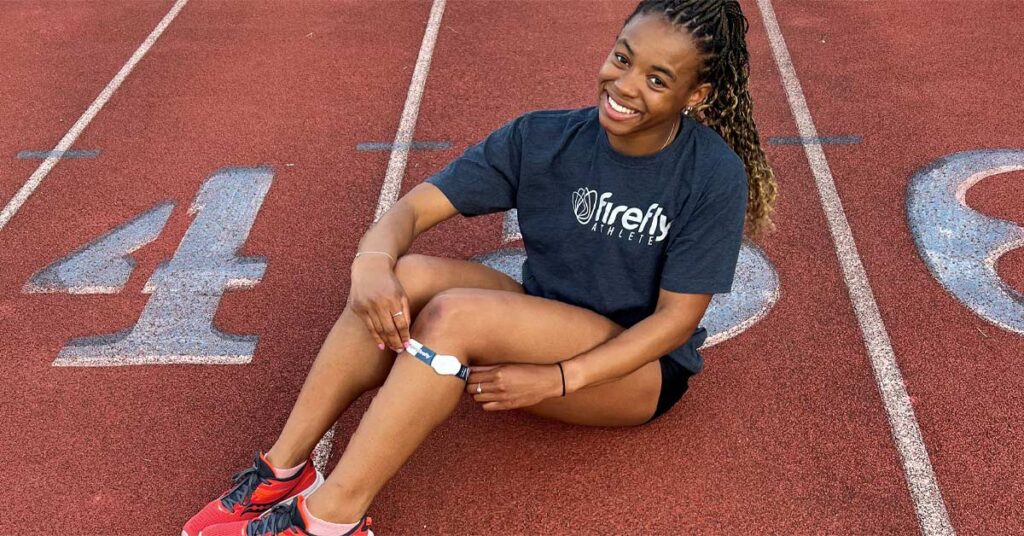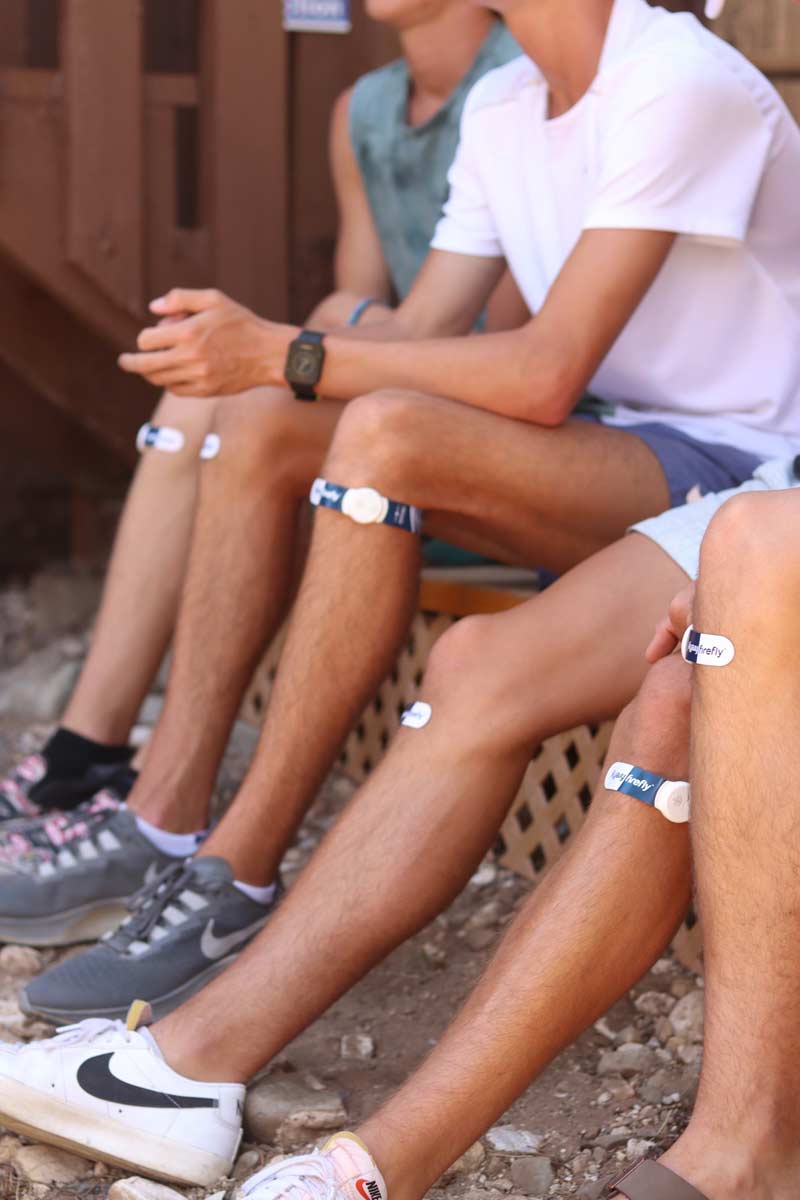Helping High School Athletes Recover Faster with Firefly Recovery

By Lauren Campbell & Conlan Sodrosky
Although high school athletes, coaches, and parents recognize the critical importance of recovery in athletic performance, it is often difficult for high school athletes to fit adequate recovery time into their demanding schedules. Finding time to recover is even more critical for track and field athletes, such as distance runners who can run upward of 60–75 miles per week, placing tremendous strain on young bodies.
Prioritizing recovery is the backbone of athletic success, playing a pivotal role in performance optimization and injury prevention. With their developing bodies and intense training schedules, high school athletes are particularly vulnerable to the cumulative effects of physical exertion. Efficient recovery becomes essential in ensuring sustained performance and long-term athletic development.
In the competitive landscape of high school track and cross country, achieving peak performance is a constant pursuit. Track athletes strive to attain PRs and break school and state records while often seeking to compete at a collegiate level. However, the demanding nature of training and racing often leaves young athletes susceptible to fatigue and delayed recovery. Recognizing these challenges, coaches across the nation have turned to the Firefly Recovery device to address the unique and demanding needs of their high school track athletes. Firefly Recovery is used by more than 700 professional and collegiate teams to help their athletes recover faster and perform better.
High school students juggle academic commitments, social engagements, jobs, extracurricular activities, and family responsibilities, leaving them with limited time for adequate rest and recovery. Balancing rigorous training regimens with academic pressures can lead to increased stress, diminished sleep, and heightened fatigue, which can impede physical and mental well-being. The keys to recovery are well known—adequate sleep, sufficient hydration, and proper nutrition—but finding time for this with all of the other commitments can be challenging. In addition, many athletes look for additional ways to boost their recovery but struggle to find time to fit another task into their busy days.
Gaining an Edge in Recovery
Athletic recovery is built on the cornerstones of proper nutrition, hydration, quality sleep, cross-training, and strength training. The Firefly Recovery device provides a cutting-edge addition to elevate your recovery that is tailored to the unique demands faced by high school track and cross-country athletes. This innovative technology employs neuromuscular electrical stimulation, complementing traditional recovery practices by enhancing blood circulation, promoting targeted muscle recovery, and reducing recovery time.
These small, portable, and user-friendly devices (recognized as the GQ Winner of Best Wearable Recovery Device) leverage a non-invasive appearance, which makes them an ideal choice for young athletes seeking an efficient and convenient recovery solution. The devices can be used pre or post training or meet and can even be worn in the car or during class.
How It Works
Firefly sends small electrical pulses to gently stimulate your peroneal nerve (which runs from the hip to the toe) and creates a slight foot “flutter” or twitch, which increases blood flow to speed up recovery. Firefly functions as a science-based, “passive soleus pump” that stimulates the lymphatic response and increases venous and arterial blood flow back to your heart. Increased blood flow means your muscles get more oxygen and nutrients, which helps your body recover from exercise faster and reduces soreness.
Video 1. Pro beach volleyball player and five-time Olympian Kerri Walsh explains the simple steps to use the device.
Firefly is versatile and can be used:
- Pre-workout as a warm-up (30–60 minutes).
- Post-training or meet to recover (1–4 hours).
- During travel to promote healthy blood flow and keep legs feeling fresh (duration of travel).
Results on the Track
North Scott High School in Eldridge, Iowa, and Montour High School in Pittsburgh, Pennsylvania, are two programs that have adopted Firefly for their track athletes. By integrating the recovery tool, their young runners can reduce fatigue and foster a holistic approach to well-being throughout their athletic journey.
“This past spring, we had a number of kids qualify and run in four different events over a three-day state track meet,” said Tony Stewart, Head Strength and Conditioning Coach at North Scott High School. “We were able to provide them each with a pair of Firefly devices that they used at the hotel in the evening to help recover from the day and be prepared to compete again the following day. All of our athletes reported back that they loved the device.”
High school athletes using Firefly have reported a noticeable reduction in muscle fatigue and soreness. The targeted neuromuscular stimulation facilitates enhanced blood flow, expediting the removal of metabolic waste and promoting a quicker recovery turnaround. Firefly’s positive impact on reducing fatigue ensures that athletes approach each session with increased readiness, fostering consistent and sustainable performance increases.
“When it comes to the recovery efforts for high school track athletes and the year-round training and competition, it is essential to have a recovery tool that is efficient, portable, and easy to use,” said Jay Martinez, Head Strength and Conditioning Coach at Montour High School.
“Incorporating the Firefly recovery tool for our athletes has been an essential part of how we do things at Montour High School. The recovery and the ability for athletes to rebound for back-to-back training sessions has been great. The feedback from the athletes has been nothing but positive; they feel less fatigued when they have them and more recovered, while the soreness that usually comes days after high-intensity training days has been diminished.”
Video 2. Recent high school graduates Leo and Lex Young received national attention for their stellar performance at Newbury Park High School, where they broke school, state, and national records. Here, they discuss how Firefly Recovery works and why they enjoy using it.
There is an additional psychological benefit to recovery that is explained by Dr. Jim Taylor, an internationally recognized authority on the psychology of athletic performance.
“Firefly recovery devices are ideal for high school track athletes because they ensure a faster physical recovery from intense workouts and hard race efforts,” said Dr. Taylor, who is also a professional triathlete. “They also provide psychological benefits because when you’re feeling rested and recovered, and your body feels good, you’ll be motivated, confident, relaxed, and focused for upcoming workouts and races. Firefly devices are also practical because you can wear them in class, on the bus, almost anywhere, so you can actively recover even with your demanding schedule.”
The efficacy of Firefly is further supported by a clinical study that underscores its superiority in enhancing blood microcirculation compared to intermittent compression boots. The study demonstrates that Firefly’s neuromuscular electrical stimulation (NMES) technology surpasses traditional compression methods in promoting more efficient blood flow, a crucial factor in accelerated recovery. Moreover, the findings suggest that incorporating Firefly into the rehabilitation process post-lower limb injury can be particularly advantageous for athletes.
The device’s ability to aid both physiological and psychological aspects of recovery has been observed to lead to significant performance increases within just 24 hours post-strenuous exercise. This scientific validation further solidifies Firefly as an invaluable tool for high school track and cross country athletes, not only offering tangible physical benefits but also contributing to the overall well-being and resilience of these young competitors. By addressing the unique challenges young athletes face, the device emerges as a game-changer, empowering the next generation of runners to navigate their demanding schedules with resilience, improved recovery, and a renewed capacity for athletic excellence.
Frequently Asked Questions
Does Firefly have clinical studies?
Yes, Firefly has been clinically validated to improve recovery. Please review our clinical studies on the Firefly website.
How does Firefly differ from muscle stim?
The Firefly is a modified NMES that stimulates a nerve versus a muscle; it is not a muscle stim or TENS unit. Stimulating the peroneal nerve causes muscles to contract and increase blood flow. Stimulating a muscle (with traditional NMES) for extended periods can cause muscle fatigue. The Firefly safely avoids muscle fatigue that can be caused by TENS.
Is Firefly a single-use device?
The Firefly device is reusable during the 30-hour life of the battery and can be used for multiple recovery sessions. Afterward, the battery can be removed and recycled like any household battery but cannot be replaced. The Firefly device is not rechargeable at this time. We are looking at ways to extend the life of the product and make Firefly rechargeable.
How much does Firefly cost?
One pack of Firefly Recovery devices costs $48 and is available in the Firefly Recovery Shop. In addition, Firefly offers subscriptions and bundles to reduce the price so that the total cost is under $1.50 per hour of treatment.
